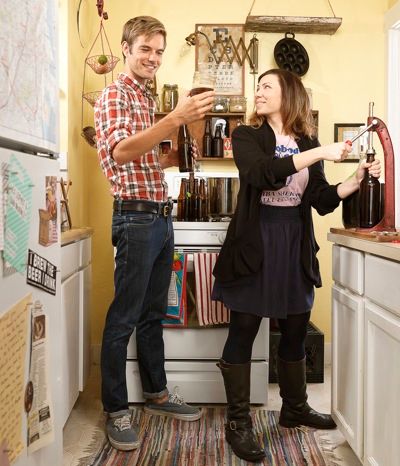SF-based designer Jessi Rymill and writer William Bostwick, authors of the Beer Craft (out today!) have brewed over 150 batches of beer in the last two years. Their method is a little different from what you might learn from the Grizz at SF Brewcraft’s introductory classes. Instead of focusing on large batches (that weigh a ton and take up half your closet space), they've zeroed in on the perfect batch size for small-spaced, urban living: one gallon. The writer/designer team have shared their findings in a beautifully designed, easy-to-follow book that includes a short lesson on beer history, interviews with brewers across the country, and plenty of information about equipment, recipes, and ingredients that will inspire and empower any aspiring homebrewer to get creative. Every page of tips, steps, and factoids is accompanied by colorful illustrations and infographics. We sat down to chat with William and Jessi about their process, their 23-brewery cross-country road trip, and their beer philosophy. And, of course, we got to taste some of their brews—a smoked malt rye and a coffee porter—and can vouch for their deliciousness.
7x7: At what point did you decide you'd brewed enough beer that you wanted to write a book about it?
William Bostwick: Oh, it only took one. Because it exploded. It went to so badly that we thought there has to be a better way.
Jessi Rymill: Well, the first thing we did was buy a kit and follow the directions. That was the batch that exploded. So then we spent a good 3 months trying to read books and figure out how to do the one-gallon all-grain batch and use five gallon recipes and figure out how the equipment would work. And then we realized——
WB: We realized there's a book here. We had amassed all this information and were basically writing these recipes for ourselves. We knew that we didn't want to do five gallons because our stove was too small for our apartment space, and we knew we didn't want to do extract because it seemed like less fun.
JR: The first month, we moved out of our apartment [in Brooklyn], moved up to the Hudson Valley, and spent a month just making beer all the time.
WB: We ensconced ourselves in a cabin in the woods and just made beer. Multiple batches a day, beer after beer after beer.
7x7: Multiple batches a day? So you had more than one brewing kit?
WB: Oh, at that point we could kind of cobble together our own.
JR: There was a lot of experimenting with equipment, we tried as a mash tun different sizes and types of coolers.Basically we tried all the things that people use for 5-gallon batches and we realized how different it is. So at every corner of the process we just came up with what we thought would work best. Then we had our process in place.
WB: One of the reasons we like making one-gallon batches is that we can experiment. You use far less ingredients and obviously less money so it's less risk.
7x7: And if that five gallons tastes terrible you're stuck with five gallons of it.
WB: I made George Washington's beer once. Five gallons of that would've been bad, but one gallon was interesting. If you had to like stare down a fridge of fifty bottles of that stuff it will make you hate George Washington.
7x7: What's your favorite that you've brewed so far? Do you have a favorite batch?
JR: Today I'm really into the coffee brown we just made.
7x7: The one with Ritual coffee?
JR: Yeah, one of the three that we made with their coffee. I finally understand—through our trip and all the brewers we talked to—we had to ask, "What's your favorite beer that you made?" and they're all like, "None of them are my favorite, they're all my children," which was an analogy that I didn't quite get. But now that we're making beer...
7x7: It makes sense?
JR: Yeah it makes sense.
7x7: Did you learn everything you know about beer just by drinking and talking to people on your trip?
WB: Mostly by making it. Because you can talk about what different kind of malts smell and taste like forever, but until you put smoked malt in a beer and then put peated malt in another beer, and smell it while you're mashing it and while you're boiling it and while you're drinking it—
JR: You want to eat the malt while you're drinking the beer.
WB: And we learned a lot from the brewers but nothing can compare with just making it. I hope that's something that we can inspire by trying to make homebrewing easy and accessible. People are really into beer. We found that when we get really into something, we want to see how it's done, because you learn more. And so we hope that by making homebrew seem easy it will get all the people at Monk's Kettle saying, "Oh maybe I can try that!" And then you learn something!
JR: It's easy to make beer. It's hard to make really great beer. So it also helps you to appreciate whatever your favorite beer is. You don't need to try to make it at home because you can buy it and that's a good thing. But you can also try to make a raspberry porter or a smoked wheat beer or a dark rye sour or whatever you're inspired to try.
WB: It expands your beer horizons. You get curious about weird stuff.
You can buy Beer Craft online, but it will also be on sale at Magnolia, giving you an excuse to grab a pint (as if you really need one).
Related Articles
